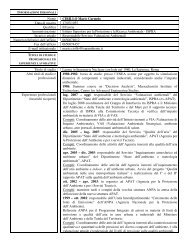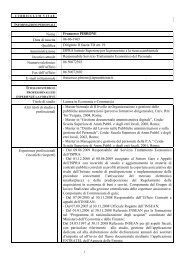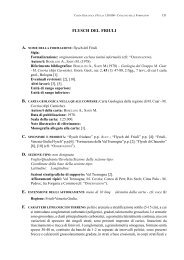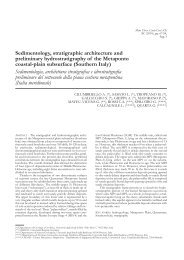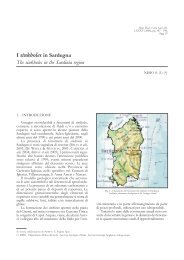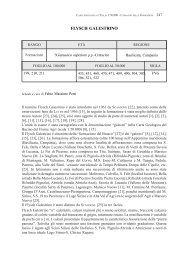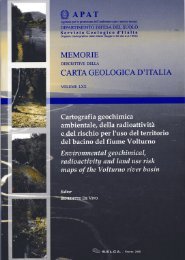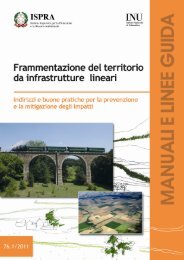Guidebook - Ispra
Guidebook - Ispra
Guidebook - Ispra
You also want an ePaper? Increase the reach of your titles
YUMPU automatically turns print PDFs into web optimized ePapers that Google loves.
Volume n° 1 - from PR01 to B15<br />
B12<br />
B12 -<br />
Leader: M. Sandulescu<br />
Transylvanian Depression is crossed by the national<br />
road which is followed by the fieldtrip. In some quarries<br />
on the slope, north of the road, the Dej Tuff crops<br />
out. It is a general marker of the basal sequence of the<br />
Depression clearly followed in boreholes and on the<br />
seismic lines.<br />
Stop 3.9:<br />
Panoramic view of the innermost part of the<br />
Carpathian Bend Area.<br />
From Șercaia village it is possible to have a panoramic<br />
view of the Perșani Mts., the Vlădeni Couloir,<br />
the Dealu Mare (South Transilvanian) Fault and the<br />
north-eastern end of the Făgăraș Mts. The highest<br />
visible relief of the Perșani Mts. corresponds to a<br />
large domal anticline (Gârbova Anticline) in the core<br />
of which metamorphic formations of the Bucovinian<br />
Nappe crop out. On the north-western slope (left-hand<br />
slope of Gârbova Mts.) the whole sedimentary succession<br />
of the nappe develops. The south-eastern slope is<br />
overlain by the Upper Cretaceous post-tectogenetic<br />
cover of the Bucovinian Nappe. It corresponds to the<br />
northern limb of the Vlădeni Depression. The Dealu<br />
Mare Fault is well expressed in relief (see above). The<br />
Făgăraș Mts., with the beautiful panorama of their<br />
skyline, correspond - with a small exception - to the<br />
Subbucovinian Nappe. On a small area at Șinca Nouă<br />
and Vârful lui Petru (the latter visible as the highest<br />
peak on the skyline), a tectonic outlier of the Bucovinian<br />
Nappe is preserved.<br />
From Șercaia to Sibiu the fieldtrip runs across the<br />
southernmost part of the Transylvanian Depression.<br />
Southward (left-hand) the Făgăraș Mts. border the<br />
Depression. Northward the hills are built up of Sarmatian<br />
and, mostly, Pannonian formations.<br />
Sibiu is also an important medieval town. The<br />
Evangelic Cathedral was built in the oldest part of<br />
the town, where the medieval architecture was well<br />
preserved. Parts of the defence works of the XV th -<br />
XVI th centuries are also well preserved. The Ortodox<br />
Cathedral was the first one built in Transylvania,<br />
showing an architecture similar to that of Saint Sophia<br />
in Constantinople. The Brukenthal Museum* is the<br />
oldest painting exhibition, opened one year before<br />
the Louvre.<br />
DAY 4<br />
Sibiu - Alba Iulia - Câmpeni<br />
From Sibiu to Alba Iulia the fieldtrip runs along the<br />
southern border of the Transylvanian Depression. Af-<br />
ter crossing Alba Iulia, the fieldtrip enters the Ampoi<br />
Valley.<br />
Stop 4.1:<br />
Șard - Miocene molasse.<br />
The oldest formations belonging to the Transylvanian<br />
Depression, cropping out in the Alba Iulia area, are<br />
exposed in Șard, on the right-hand bank of Ampoi<br />
Brook. Conglomerates, microconglomerates and<br />
coarsegrained sandstones of red or grey colour may<br />
be examined. The pebbles and grains are of different<br />
types, proceeding from the Miocene erosion of the<br />
South Apuseni Mountains.This molassic formation<br />
is older than the Dej Tuff (Lower Badenian). Consequently<br />
they may be correlated with the Hida Formation<br />
which is of uppermost Burdigalian/lowermost<br />
Badenian age.<br />
After Șard, along the Ampoi Valley the fieldtrip runs<br />
across the Feneș Unit of the South Apuseni Mts.<br />
(Transylvanides).<br />
Stop 4.2:<br />
Ampoi Valley - the Meteș Formation.<br />
The Upper Aptian -Albian sequence of the Feneș<br />
Nappe is represented by the Meteș Formation. This<br />
is a typical wildflysch formation, the sedimentary<br />
klippen (“olistoliths”) being represented by ophiolitic<br />
and sedimentary rocks which proceed from the inner<br />
(southern and eastern) units (Techerău-Drocea and<br />
its prolongation east of the Brad Depression, or the<br />
Trascău Nappe).<br />
The outcrops of the Meteș Formation show a layered<br />
(turbiditic) or massive siltic matrix and sedimentary<br />
klippen of: basalts, calc-alkaline rocks, Oxfordian, Tithonian<br />
and/or Urgonian (Barremian-Lower Aptian)<br />
limestones.<br />
The road continues across the same Meteș Formation,<br />
the landscape dominated by characteristic “Klippen”<br />
of Upper Jurassic limestone olistoliths. Between<br />
Poiana Ampoiului and Presaca Ampoiului, the area is<br />
built up by the Fenes Formation, but the favourable<br />
exposures are situated on the left (northern) affluents<br />
and slopes.<br />
At Presaca Ampoiului, after crossing a fault, the road<br />
enters the Valea lui Paul Formation in which some<br />
Upper Jurassic olistoliths can be observed (Bleahu<br />
et al., 1981).<br />
Stop 4.3:<br />
Feneș valley. Very low-grade Feneș beds.<br />
Along the Feneș valley siltic clayș chemolitic lime-




